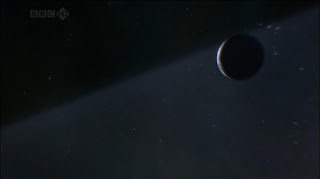
Pocas veces vi una serie científica con semejante producción. La serie
“Wonders of the Solar System”, de la BBC y presentada por el profesor Brian Cox, no tiene desperdicio. El tip, via
Microsiervos.
Me resultaron excelentes:
La idea: Presentar el sistema solar en conexión con lugares y cosas que pasan en la tierra, de manera simple pero con rigurosidad, algo que no abunda.
La ejecución: El guacho HdP –no hay otra forma de describir a Cox- se paseó por medio mundo, viendo los fenómenos más variados y espectaculares en la naturaleza, los mejores observatorios del mundo, etc., y además le pagan. La fotografía es impresionante.
Los contenidos: Me sorprendió la vastedad y claridad con que se presentan gran cantidad de conceptos en una hora que dura cada episodio. Y aunque ya conociera la mayoría de los temas, encontré en cada presentación suficientes detalles y cosas como para aprender algo nuevo o interesante.
Lo negativo:
Muy poco… podemos mencionar el abuso de adjetivos... “remarkable”, “outstanding”, “fascinating”, etc. Por otra parte, Cox tiene mucha presencia en pantalla, lo cual puede dividir… si el flaco no te cae bien o no te copa su tonito inglés, pienso que puede desgastar bastante. Pero para mí, no fue el caso.
Episode 1 - Empire of the sunEclipses I think these are my favourites (…) These are pictures taken from the surface of Mars by the Opportunity Rover, looking up at the sun, and zou can see Mars’s moon Phobos as it makes its way across the disk of the sun. (…) So this is a partial solar eclipse from the surface of another world.Energía del sol
I think these are my favourites (…) These are pictures taken from the surface of Mars by the Opportunity Rover, looking up at the sun, and zou can see Mars’s moon Phobos as it makes its way across the disk of the sun. (…) So this is a partial solar eclipse from the surface of another world.Energía del sol So how much energy does fall on the surface of the Earth from the Sun? You can work it out with a beautifully simple experiment using only a thermometer a tin full of water and an umbrella. Basically, you let the water heat up in the tin to ambient temperature (…) then you put the thermometer in the water and take the shade away, and let the sun shine on the water. In direct sunlight the water temperature begins to rise. By timing how long it takes the sun to raise the water temperature by one degree Celcius, you can figure out exactly how much energy has the sun delivered into the can of water, and from that, how much energy to a square meter of the surface. (…) It turns out that number is about a Kilowatt. (…) In an audacious leap of imagination, Herschel used this figure to calculate the entire energy given up by the sun (…) It’s 400 million, million, million, million watts.Formación estelar
So how much energy does fall on the surface of the Earth from the Sun? You can work it out with a beautifully simple experiment using only a thermometer a tin full of water and an umbrella. Basically, you let the water heat up in the tin to ambient temperature (…) then you put the thermometer in the water and take the shade away, and let the sun shine on the water. In direct sunlight the water temperature begins to rise. By timing how long it takes the sun to raise the water temperature by one degree Celcius, you can figure out exactly how much energy has the sun delivered into the can of water, and from that, how much energy to a square meter of the surface. (…) It turns out that number is about a Kilowatt. (…) In an audacious leap of imagination, Herschel used this figure to calculate the entire energy given up by the sun (…) It’s 400 million, million, million, million watts.Formación estelar Those dark areas are called molecular clouds (…) that lie between us and the stars of the Milky Way galaxy. These dark clouds contain the raw material from which stars are made. (…) over millennia they begin to condense. That means that the weak force of gravity can take over and begin to clump the hydrogen together. Now, we have a name for clumps of hydrogen collapsing under their own gravity… stars. (…) They begin to heat up and eventually they become hot enough for the hydrogen to fuse together into helium. The stars ignite, the clouds are no longer black. The fusion of hydrogen into helium is the foundation of all the sun’s power.Ciclo solar
Those dark areas are called molecular clouds (…) that lie between us and the stars of the Milky Way galaxy. These dark clouds contain the raw material from which stars are made. (…) over millennia they begin to condense. That means that the weak force of gravity can take over and begin to clump the hydrogen together. Now, we have a name for clumps of hydrogen collapsing under their own gravity… stars. (…) They begin to heat up and eventually they become hot enough for the hydrogen to fuse together into helium. The stars ignite, the clouds are no longer black. The fusion of hydrogen into helium is the foundation of all the sun’s power.Ciclo solar Just look at how much water there is. Every molecule in this river, every molecule in every raindrop in every cloud has been transported from the Pacific, over the Andes, into the continental interior here… just imagine how much energy that is. (…) This is the Iguazu falls, a quarter of a million gallons of water flow through here every second.
Just look at how much water there is. Every molecule in this river, every molecule in every raindrop in every cloud has been transported from the Pacific, over the Andes, into the continental interior here… just imagine how much energy that is. (…) This is the Iguazu falls, a quarter of a million gallons of water flow through here every second. The greater the number of sunspots, the more powerful our star becomes (…) we discovered that the sun has seasons.
The greater the number of sunspots, the more powerful our star becomes (…) we discovered that the sun has seasons. He showed me what happens when you superimpose this solar data and the water levels on the river. (…) it’s a very striking correlation.Corona solar
He showed me what happens when you superimpose this solar data and the water levels on the river. (…) it’s a very striking correlation.Corona solar The sun’s face is now completely shrouded by the moon. Only now, during totality, is a hidden wonder of the sun revealed.
The sun’s face is now completely shrouded by the moon. Only now, during totality, is a hidden wonder of the sun revealed.
That’s the sun’s atmosphere. Those are a clouds, that’s the solar corona. (…) The sun atmosphere is strange. (…) Through mechanisms that we yet don’t fully understand, the corona is much hotter than the surface. Here temperatures sore to over a million degrees Celsius.Viento solar The magnetic field emanates from deep within our planet’s spinning, iron rich core. And it’s this gigantic force field, known as the magnetosphere that deflects most of the solar wind harmlessly away into space. But the planet doesn’t escape completely (…) Eventually the energy is released, accelerating a stream of electrically charged particles down the field lines towards the poles. And when these particles (…) hit the Earth’s atmosphere, they create one of the most beautiful sights in nature.
The magnetic field emanates from deep within our planet’s spinning, iron rich core. And it’s this gigantic force field, known as the magnetosphere that deflects most of the solar wind harmlessly away into space. But the planet doesn’t escape completely (…) Eventually the energy is released, accelerating a stream of electrically charged particles down the field lines towards the poles. And when these particles (…) hit the Earth’s atmosphere, they create one of the most beautiful sights in nature. Both Voyager spacecrafts are constantly measuring solar wind as it fades away. One day soon they WILL find the place where the Sun’s last physical trace finally runs out.Nube de Oort
Both Voyager spacecrafts are constantly measuring solar wind as it fades away. One day soon they WILL find the place where the Sun’s last physical trace finally runs out.Nube de Oort And that cloud of snow balls is called the Oort cloud [which] extends out to 50,000 astronomical units. (…) This is the full extent of the Sun’s empire. The lightest gravitational touch, which retains a cloud of ice, enclosing the Sun in a colossal sphere. Beyond the Oort cloud, there is nothing.Diagrama Hertzprung-Russell
And that cloud of snow balls is called the Oort cloud [which] extends out to 50,000 astronomical units. (…) This is the full extent of the Sun’s empire. The lightest gravitational touch, which retains a cloud of ice, enclosing the Sun in a colossal sphere. Beyond the Oort cloud, there is nothing.Diagrama Hertzprung-Russell The next thing you notice is that [stars] are actually coloured. (...) Astronomers have gazed upon a galaxy full of stars, at all stages of their lives. (…) They’ve meticulously charted the nearest 10,000 of them, and then arranged each according to its colour and brightness. What emerges is one of the most powerful and elegant tools in the whole of astronomy. The Hertzprung-Russell diagram.
The next thing you notice is that [stars] are actually coloured. (...) Astronomers have gazed upon a galaxy full of stars, at all stages of their lives. (…) They’ve meticulously charted the nearest 10,000 of them, and then arranged each according to its colour and brightness. What emerges is one of the most powerful and elegant tools in the whole of astronomy. The Hertzprung-Russell diagram. This diagram allows astronomers to predict the history and evolution of stars, and in particular the future life of our sun. (…)Final del sol
This diagram allows astronomers to predict the history and evolution of stars, and in particular the future life of our sun. (…)Final del sol Eventually, the fuel will run out, and its core will collapse. Then something remarkable will happen. The sun’s outer layers will expand, and its colour will shift. Mercury will be little more than a memory as it is engulfed by the expanding red Sun. (…) our own planet’s prospects are dim. (...) For a few brief instants it will be 2000 times as bright as it is now, but that won’t last for long, eventually it will shed its outer layers and all that will be left will be its cooling core, a faint cinder that will glow, well... pretty much until the end of time.
Eventually, the fuel will run out, and its core will collapse. Then something remarkable will happen. The sun’s outer layers will expand, and its colour will shift. Mercury will be little more than a memory as it is engulfed by the expanding red Sun. (…) our own planet’s prospects are dim. (...) For a few brief instants it will be 2000 times as bright as it is now, but that won’t last for long, eventually it will shed its outer layers and all that will be left will be its cooling core, a faint cinder that will glow, well... pretty much until the end of time.


























































